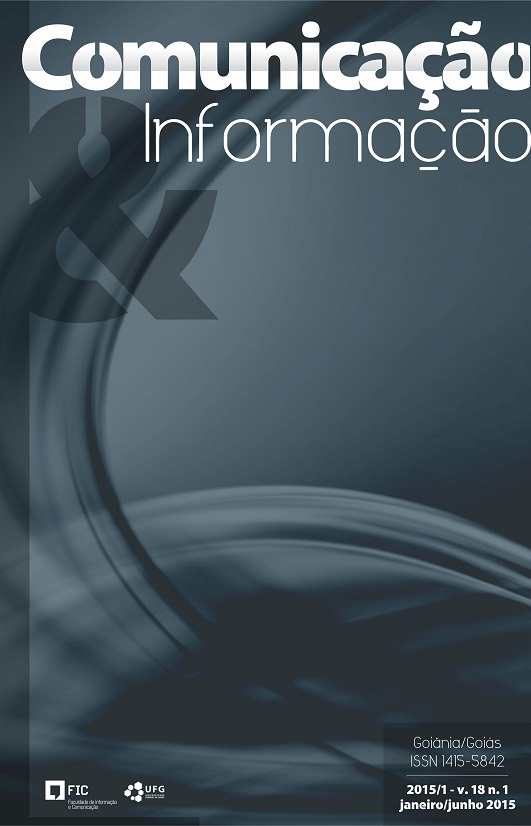El uso de técnicas de juego para el análisis de la información visual
DOI:
https://doi.org/10.5216/32365Palabras clave:
Técnicas de juego. Gamificación. Interacción persona-ordenador (HCI). Analítica visual. Proceso de decisión.Resumen
La sobrecarga de información y datos de abundancia, con la diversidad en forma y contenido, hacen más complejo el proceso de toma de decisiones. Por otra parte, la presentación visual de la información ha sido una alternativa interesante para apoyar a los directivos y especialistas. Sin embargo, es necesario que las interfaces son apropiadas para facilitar y promover el análisis de la información. En este contexto, el presente artículo se describen investigaciones utilizando concepto de juegos. Explora la importancia de la gestión de la información, el uso de la gamificación para el análisis de la información visual, así como las motivaciones psicológicas relacionadas con las mecânicas de los juegos en proceso de toma de decisiones. Debido al bajo número de estudios sobre gamificación en esta área, el artículo presenta reflexiones pertinentes sobre el tema.
Descargas
Citas
CODECADEMY. Aprenda a programar de maneira interativa e gratuita. [S. l.], [201-]. Disponível em: <http://www.codecademy.com>. Acesso em: 31 Ago. 2014.
DAVENPORT, T. H.; PRUSAK, L. Information ecology: mastering the information and knowledge environment. USA: Oxford University Press, 1997.
DETERDING, S. et al. From game design elements to gamefulness: defining “gamification”. In: INTERNATIONAL ACADEMIC MINDTREK CONFERENCE: ENVISIONING FUTURE MEDIA ENVIRONMENTS. 15., 2011, Tampere, Finland. Proceedings… New York: ACM, 2011. p. 9-15.
DETERDING, S. Gamification: designing for motivation. Interactions, v. 19, n. 4, p. 14 - 17, 2012.
EBERT, A.; GERSHON, N. D.; VEER, G. V. der. Human-computer interaction: introduction and overview. Künstliche Intelligenz, v. 26, n. 2, p. 121 – 126, 2012.
FERRO, L. S.; WALZ, S. P.; GREUTER, S. Towards personalised, gamified systems: an investigation into game design, personality and player typologies. In: AUSTRALASIAN CONFERENCE ON INTERACTIVE ENTERTAINMENT: MATTERS OF LIFE AND DEATH. 9., 2013, Melbourne, Australia. Proceedings… New York: ACM, 2013. p. 1-6.
GARTNER. Gartner says by 2015, more than 50 percent of organizations that manage innovation processes will gamify those processes. Newsroom, Egham, UK, april 2011. Disponível em: . Acesso em: 19 out. 2014.
GARTNER. Gartner says by 2014, 80 percent of current gamified applications will fail to meet business objectives primarily due to poor design. Newsroom, Stamford, Conn. nov. 2012. Disponível em: . Acesso em: 19 out. 2014.
GOODMAN, S. K. Information needs for managing decision-making. Records Management Quaterly, v. 27, n. 4, p. 12-23. 1993.
HAMARI, J.; KOIVISTO, J.; SARSA, H. Does gamification work? A literature review of empirical studies on gamification. In: HAWAII INTERNATIONAL CONFERENCE ON SYSTEM SCIENCES. 47., 2014, Hawaii, USA. Proceedings… Hawaii, USA, 2014. p. 3025-3034.
HÄGGLUND, P. Taking gamification to the next level: a detailed overview of the past, the present and a possible future of gamification. Student thesis (Degree of bachelor)-Umeå Universitet, Umeå, 2012.
IANDOLI, L.; KLEIN, M.; ZOLLO, G. Can we exploit collective intelligence for collaborative deliberation? The case of the climate change collaboratorium. MIT Sloan Research Paper, Massachusetts, n. 4675, jul. 2008. Disponível em: < http://ssrn.com/abstract=1084069>. Acesso em: 19 out. 2014.
KARACAPILIDIS, N.; PAPADIAS, D. Computer supported argumentation and collaborative decision making: the HERMES system. Information Systems, v. 26, n. 4, p. 259-277, 2001.
KENNERLEY, M.; MASON, S. The use of information in decision making: literature review for the Audit Commission. Centre for Business Performance, Cranfield School of Management, 2008. Disponível em: <http://archive.audit-commission.gov.uk/auditcommission/sitecollectiondocuments/AuditCommissionReports/NationalStudies/Cranfield_Information_use_review.pdf>. Acesso em: 04 Out. 2014.
KHAN-ACADEMY. A free world-class education for anyone anywhere. 2014. Disponível em:<http://www.khanacademy.org/>. Acesso em: 04 Out. 2014.
MADUREIRA, V. Gamificação: mais do que uma tendência, uma estratégia. Marketing Digital, [S. l.], 2012. Disponível em: <http://imasters.com.br/midia-e-marketing-digital/web-marketing/gamificacao-mais-do-que-que-uma-tendencia-uma-estrategia/>. Acesso em: 04 Out. 2014.
MARCZEWSKI, A. Gamification: a simple introduction & a bit more. [S. l.]: Kindle edition, 2013.
MILLER, C. et al. Orchestrating data, design, and narrative: information visualization for sense- and decision-making in online learning. International Journal of Cyber Behavior, Psychology and Learning, USA, v. 2, n. 2, p. 1-15, 2012.
MIRANDA, S. V.; STREIT, R. E. O processo de gestão da informação em organizações públicas. In: ENCONTRO DE ADMINISTRAÇÃO DA INFORMAÇÃO, 1., 2007, Florianópolis. Anais... Santa Catarina: Anpad, 2007. p. 1-17.
MELONI, W.; GRUENER, W. Gamification in 2012. [S. l.]: M2 Research, 2012. Disponível em: <http://gamingbusinessreview.com/wp-content/uploads/2012/05/Gamification-in-2012-M2R3.pdf >. Acesso em: 05 Ago. 2014.
MORRISON, B. B.; DISALVO, B. Khan academy gamifies computer science. In: ACM TECHNICAL SYMPOSIUM ON COMPUTER SCIENCE EDUCATION, 45, 2014, New York, USA. Proceedings… New York: ACM, 2014. p. 39-44.
PELLING, N. The (short) prehistory of “gamification”… Funding Startups (& other impossibilities), [S. l.], 2011. Disponível em: <http://nanodome.wordpress.com/2011/08/09/the-short-prehistory-of-gamification/>. Acesso em: 04 out. 2014.
SANFILIPPO, A. et al. Psychosocial and cultural modeling in human computation systems: a gamification approach. In: MICHELUCCI, P. (ed.). Handbook of human computation. New York: Springer, 2013.
SAP StreamWork Online Help. [S. l.]: SAP StreamWork. Disponível em: <https://streamwork.com/help/12Sprints.html>. Acesso em: 18 Out. 2014.
SAWANT, A. P.; HEALEY, C. G. Need for perceptual display hierarchies in visualization. XRDS: Crossroads, The ACM Magazine for Students, v. 13, n. 3, 2007.
THOMAS, J. J.; COOK, K. A. Illuminating the path: the research and development agenda for visual analytics. Los Alamitos, USA: IEEE Computer Society, 2005.
WERBACH, K.; HUNTER, D. For the win: how game thinking can revolutionize your business. Philadelphia: Wharton Digital Press, 2012.
WILSON, I. You must remember this. Canada: Institute on Governance, 1999. Disponível em: <http://mercury.ethz.ch/serviceengine/Files/ISN/121818/ipublicationdocument_singledocument/1435f0c5-d8dc-499d-8c76-bd2986d741ee/en/you_must_remember.pdf>. Acesso em: 19 Out. 2014.
CUNNINGHAM, C.; ZICHERMANN, G. Gamification by design: implementing game mechanics in web and mobile apps. Sebastopol: O’Reilly Media, 2011.
Publicado
Cómo citar
Número
Sección
Licencia
Os autores dos trabalhos publicados na revista Comunicação e Informação retêm os direitos autorais sem restrições e concedem à revista o direito de primeira publicação, com o trabalho simultâneo licenciado sob a Licença Creative Commons Atribuição-NãoComercial que permite o compartilhamento do trabalho para fins não comerciais com reconhecimento da autoria e o privilégio de publicação primeiramente por esta revista. Caso o texto venha a ser publicado posteriormente em outro veículo, solicita-se aos autores informar que o mesmo foi originalmente publicado como artigo na revista Perspectiva, bem como citar as referências bibliográficas completas dessa publicação.
Os direitos autorais dos artigos pertencem aos autores e o conteúdo dos artigos assinados é de responsabilidade exclusiva dos autores.
A revista se reserva o direito de efetuar, nos originais, alterações de ordem normativa, ortográfica e gramatical, com o intuito de manter o padrão culto da língua, respeitando, porém, o estilo dos autores.
A revista também se reserva o direito de traduzir o artigo, no todo ou em parte, para o inglês ou para o português, dependendo do idioma em que o artigo tenha sido escrito originalmente.



